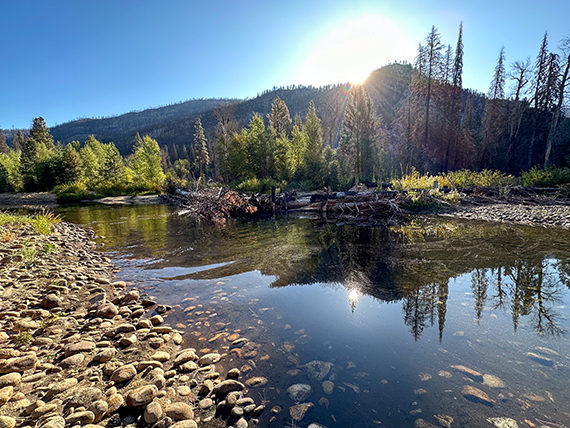Post-Fire Recovery Program
Established in 2021, The Washington State Department of Natural Resources Post Fire Recovery Program works at all levels of the disaster recovery cycle. The program operates within the Forest Resilience Division at DNR, with an overarching goal of helping communities and watersheds recover from wildfires increasing in size, severity, and long-term impacts felt across Washington.
Post-Fire Recovery relies heavily on cross-programmatic, cross-boundary coordination. Program staff aim to provide expertise and coordination on post-fire recovery efforts from an all-lands perspective, and with a focus on forest resilience.

The DNR Post-Fire Recovery Program works with partners to restore aquatic and beaver habitats in burned areas like the one pictured above. (Jessa Lewis/DNR)
The Post-Fire Recovery Program is a key part of DNR’s implementation of the 10-Year Wildland Fire Strategic Plan, 20-Year Forest Health Strategic Plan, and Forest Action Plan. Program funding is provided by the Wildfire Response, forest Restoration and Community Resilience account created in 2021 by the Washington Legislature.
Funding is intended to support post-fire recovery activities that stabilize and prevent unacceptable degradation to natural and cultural resources and minimize threats to life and property resulting from the effects of a wildfire, as well as and long-term efforts to increase the resilience of the landscape and communities against future disturbance.
The program is poised to invest more than $1 million to improve communications tools, facilitate a coordinated, statewide post-fire recovery network, invest in communities to mitigate fire impacts, support post-fire training of natural resource workforce, and support long-term recovery efforts.

An example of post-wildfire debris flow. (DNR File Photo)
Specific Program Actions
- Preparing for the inevitability of fire by providing communities and landscapes with the best available science and tools to prepare watersheds and neighborhoods for fire. By putting as much proactive work on the ground as possible, we can build community resilience and reduce the risk of a wildfire becoming catastrophic.
- Working with land managers and community leaders during a fire to help navigate the complexities of an ongoing wildfire response concurrent with recovery efforts post-fire. This is a critical transition point where high-capacity fire suppression teams can and do support local communities.
- Finding creative ways to jumpstart recovery efforts that ensure landowners, communities, and ecosystems are on the right paths to rebuilding or reinforcing resilient ecosystems in the face of a warming climate. There are no simple answers, but examples include replanting and reseeding for native species, restoring fish habitat, and installing beaver dam analogs. These and many other post-fire activities can help break the cycle of degradation that can follow a wildfire.
- Developing long-term recovery strategies by using adaptive management strategies and available science to inform land management strategies from the local level to entire watersheds. DNR supports landscape-scale planning and strategic prioritization for specific landscapes. We use these tools to help determine adaptation and resilience strategies following high-severity wildfires in Washington.
- Coordinating across boundaries and jurisdictions. Fire doesn’t respect fences or property lines. Post-fire impacts often extend far beyond the fire perimeter. The cross-boundary nature of recovery means we must engage with partners at the local, state, Tribal, and federal levels, as well as with nonprofits and private organizations. We support a holistic approach to post-fire recovery work in conjunction with other forest health and restoration efforts.
Climate Commitment Act Post-Fire Grant Program
In July 2024, the Department of Natural Resources (DNR) launched a significant $2.5 million grant program aimed at restoring forests affected by wildfires. Funding was made available by the legislature using funds generated by the Climate Commitment Act. Eligible lands included tribes, non-profit organizations, industrial and non-industrial private landowners, local governments, and other state agencies. The grant aimed to support all elements of the reforestation pipeline, from seed collection to monitoring and evaluation, as well as partner engagement.
In August 2024, five applicants were selected, with a total awarded amount of approximately $890,000. Grantee activities scheduled include seed collection and site preparation in the fall of 2024. These efforts are crucial for ensuring the availability of native seeds and preparing the land for successful planting. Seedling sowing will also occur in the fall of 2024, with seedlings ready for the 2026 planting season. In the spring of 2025, direct reforestation will occur on three significant fires: the 2022 Bolt Creek Fire and the 2023 Oregon and Gray Fires.
Recognizing the importance of community involvement and education, the grant program also includes the organization of post-fire reforestation workshops for the public in 2025. These workshops aim to inform and engage local communities about reforestation processes, the importance of forest restoration, and how they can contribute to these efforts. Additionally, a post-fire reforestation guide for landowners will be developed and distributed in 2025. This guide is intended to provide practical information and resources to landowners interested in undertaking reforestation on their properties.
The grants explicitly exclude lands where planting is mandated by law, ensuring that the funds are directed towards reforestation efforts that might otherwise lack necessary resources. The period of performance for these grants extends until June 2025, providing a structured timeline for the completion of the planned activities.
This grant program was an excellent step in strengthening partnerships and reflects the DNR's commitment to restoring forest ecosystems and supporting communities in need of post-fire restoration. Public funding and partnerships are crucial for those communities where resources may not exist to restore their forested properties - especially after devastating wildfires. The post-fire recovery program is proud to have been able to make this investment in the reforestation pipeline and our communities.

